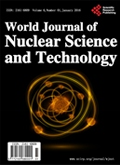 |
 |
 |
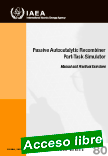 |
Passive Autocatalytic Recombiner Part-Task Simulator
Training Course Series No. 80 ¦ English ¦ IAEA-TCS-80 ¦ 60 pages ¦ Date published: 2023
This publication provides a comprehensive explanation of the passive autocatalytic recombiner part-task simulator as well as practical exercises to help readers become familiar with its use. By engaging in these exercises with the part-task simulator, readers will gain hands-on experience and a deeper understanding of its workings.
|
The objectives of this publication are to: Serve as a reference for lectures on basic principles of PAR configuration, purpose and operation; Support Member States intending to use IAEA part-tasks simulators in national education and training programmes with a resource for necessary background information on theory of PAR operation; Serve as a reference for students and trainees, who may be unfamiliar with reactor operation in accident conditions and the role of PARs and thus to understand relevant theory and mathematical models at a basic principle level; Provide exercises for use in education and training courses, use by Member State institutions, or direct use by students or trainees.
|
 |
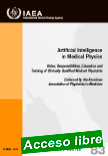 |
Artificial Intelligence in Medical Physics: Roles, Responsibilities, Education and Training of Clinically Qualified Medical Physicists
Training Course Series No. 83 ¦ English ¦ IAEA-TCS-83 ¦ 44 pages ¦ Date published: 2023
The present publication contextualizes the roles and responsibilities of clinically qualified medical physicists in the framework of the application of AI in radiation medicine. Continuing professional development activities are also suggested. The American Association of Physicists in Medicine has endorsed this publication.
|
.
|
 |
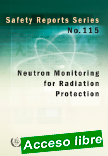 |
Neutron Monitoring for Radiation Protection
Safety Reports Series No. 115 ¦ English ¦ STI/PUB/1987 ¦ 237 pages ¦ Date published: 2023
This IAEA Safety Report describes neutron monitoring procedures and equipment that may be used for radiation protection in nuclear power production, medical and industrial applications, research institutions and civil air service. It provides guidance on measuring operational quantities of neutron radiation and practical advice for safely carrying out neutron radiation protection dosimetry, including methods for establishing traceability of those measurements to national standards.
|
This publication is intended for designers and manufacturers of radiation monitors and personal dosimeters and radiation protection professionals who develop radiation protection standards or neutron monitoring programmes.
|
 |
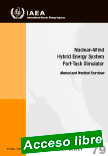 |
Nuclear–Wind Hybrid Energy System Part-Task Simulator
Training Course Series No. 79 ¦ English ¦ IAEA-TCS-79 ¦ 56 pages ¦ Date published: 2023
This publication provides a comprehensive explanation of the nuclear–wind hybrid energy
system part-task simulator as well as practical exercises to help readers become familiar with
its use. By engaging in these exercises with the part-task simulator, readers will gain hands-on
experience and a deeper understanding of its workings.
|
.
|
 |
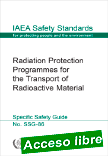 |
Radiation Protection Programmes for the Transport of Radioactive Material
IAEA Safety Standards Series No. SSG-86 ¦ English ¦ STI/PUB/2052 ¦ 79 pages ¦ Date published: 2023
This Safety Guide provides recommendations on meeting the requirements established in IAEA Safety Standards Series No. SSR-6 (Rev. 1), Regulations for the Safe Transport of Radioactive Material, 2018 Edition, for a radiation protection programme for the transport of radioactive material.
|
The objectives of a radiation protection programme for the transport of radioactive material are to provide for adequate consideration of radiation protection measures in transport; to ensure that the system of radiological protection is adequately applied; to enhance a safety culture in the transport of radioactive material; and to provide practical measures to meet these objectives. The recommendations provided in this Safety Guide are applicable to the transport of radioactive material by all modes on land, water, or in the air, including transport that is incidental to the use of the radioactive material. The intended audience for this Safety Guide includes competent authorities, consignors, carriers, consignees, and operators of ports (e.g. harbours, seaports and airports). It will also be of interest to the employees of public authorities (customs authorities, harbour authorities, port authorities) concerning activities associated with the transport of radioactive material that involve radiation exposure.
|
 |
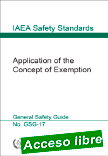 |
Application of the Concept of Exemption
IAEA Safety Standards Series No. GSG-17 ¦ English ¦ STI/PUB/2060 ¦ 127 pages ¦ Date published: 2023
Intended for use by government officials, and those working for regulatory bodies and operating organizations, this publication will assist in the application of IAEA Safety Standards Series No. GSR Part 3 in relation to the concept of exemption of practices or sources within practices from regulatory control. It addresses the application of a graded approach to the concept of exemption through the use of generic exemption and specific exemption.
|
. It explains the concept of exclusion and its relationship to exemption and clearance. The recommendations provided in this publication are applicable to all facilities and activities that use, manufacture, process, trade or store radioactive sources or material containing either natural or artificial radionuclides. The Safety Guide primarily addresses exemption from regulatory control in planned exposure situations. Although, the concept of exemption is only applicable to planned exposure situations, guidance on the application of a screening approach for decision making in managing certain existing exposure situations is also provided.
|
 |
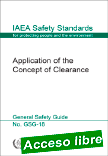 |
Application of the Concept of Clearance
IAEA Safety Standards Series No. GSG-18 ¦ English ¦ STI/PUB/2058 ¦ 127 pages ¦ Date published: 2023
Providing recommendations on the application of the concept of clearance for materials, objects and buildings that are to be released from regulatory control, this publication supports the application of the relevant requirements of IAEA Safety Standards Series No. GSR Part 3. It includes detail on the regulatory framework for clearance; the clearance process; the derivation of clearance levels; the application of clearance to solid materials, liquids and gases; generic clearance and specific clearance using activity concentration and surface contamination clearance levels.
|
It also provides recommendations on the involvement of interested parties. Written for governmental officials, and those working for regulatory bodies and operating organizations, this publication will also be of interest to technical service providers in radiation protection. The recommendations provided are applicable to facilities that use, manufacture, process or store radioactive material, such as nuclear power plants, research reactors, other nuclear fuel cycle facilities, facilities for the management of radioactive waste, industrial plants, medical facilities, research facilities, educational facilities and accelerators. The recommendations in this publication also apply to industries processing materials containing radionuclides of natural origin and to the management of material originating from remediation activities or from post- emergency situations.
|
 |
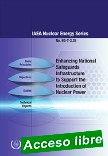 |
Enhancing National Safeguards Infrastructure to Support the Introduction of Nuclear Power
IAEA Nuclear Energy Series No. NG-T-3.25 ¦ English ¦ STI/PUB/2063 ¦ 92 pages ¦ Date published: 2023
The decision to establish a nuclear power programme is a significant undertaking by any country. Such a decision should be based on a commitment by the government to use nuclear power safely, securely and peacefully. This commitment requires establishing a sustainable national infrastructure including robust safeguards infrastructure supporting the functions of the State system of accounting for and control of nuclear material (SSAC).
|
The IAEA has developed the Milestones Approach to help Member States embarking on nuclear power to plan and develop the necessary infrastructure in a phased way. Safeguards is one of the 19 infrastructure issues described in the Milestones Approach. The primary objective of this publication is to provide guidance and references for safeguards related activities that need to be carried out during each of the three phases of nuclear power infrastructure development in line with the nuclear power programme implementation. This publication includes several case studies from different countries on how they developed their national safeguards infrastructure to meet the requirements of their nuclear power programmes.
|
 |
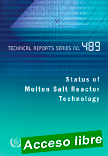 |
Status of Molten Salt Reactor Technology
Technical Reports Series No. 489 ¦ English ¦ STI/DOC/010/489 ¦ 315 pages ¦ Date published: 2023
Written to assist individuals in academia and industry and in relevant regulatory and policy roles, this publication provides a summary of the current knowledge on the status of research, technological developments, reactor designs and experiments in the area of advanced reactors that are fuelled or cooled by a molten salt. Identification of challenges and areas where research and development are still required in preparation for commercial deployment gives context to current and planned work.
|
The aim of this publication is to share information on programmes and projects on molten salt reactors in Member States which will shape future collaborative efforts.
|
 |
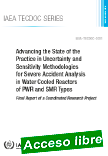 |
Advancing the State of the Practice in Uncertainty and Sensitivity Methodologies for Severe Accident Analysis in Water Cooled Reactors of PWR and SMR Types
IAEA-TECDOC-2031 ¦ English ¦ 264 pages ¦ Date published: 2023
The IAEA facilitated the co-operation on research and development, including the development and validation of computer codes for design and safety analysis of NPPs, to bring together the experts from the Member States with water cooled reactor technologies experienced in developing and using the severe accident codes to further advance the state-of-knowledge on uncertainty propagation in severe accident simulation and modelling analyses, as well as increase the sophistication and competency of the practitioners in this field.
|
This publication is one out of five in the TECDOC Series addressing specific reactor lines and it provides descriptions by contributing institutions of their utilized uncertainty and sensitivity methods for severe accidents analysis in large Pressurized Water Reactors (PWRs) and in Integral PWR-type Small Modular Reactors. This publication is intended for nuclear engineers, vendors, researchers, code developers, university professors and university students, regulatory experts, and nuclear power plant designers and planners.
|
 |
| |
|
|

|
|
|
| |
|
|
| |
| |
|
|
| |
| |
|
|
| |
| |
|
|
|
| |
| |

